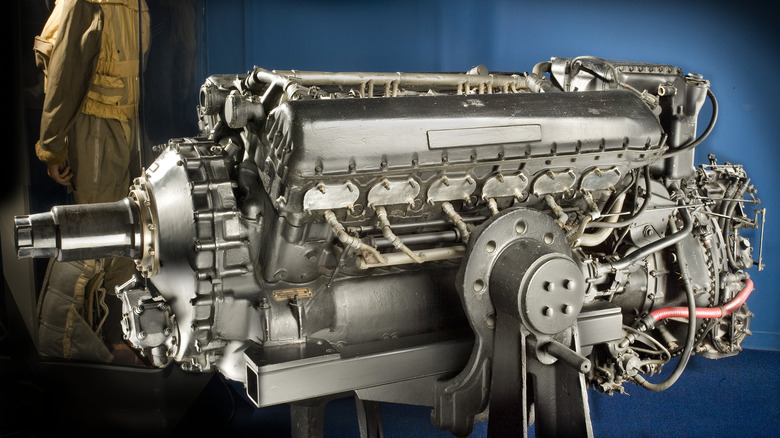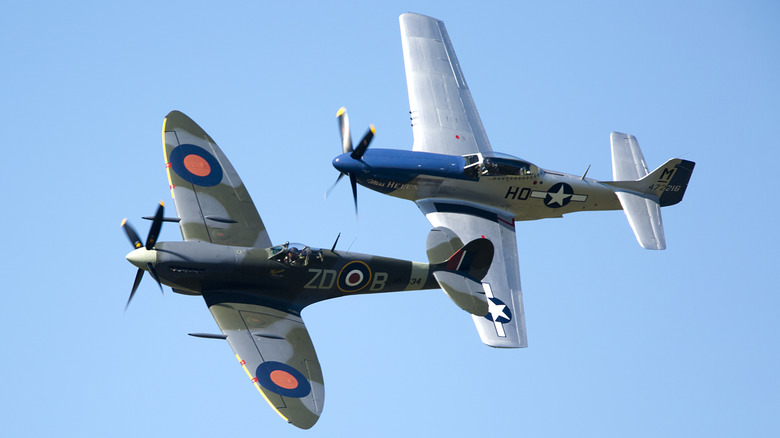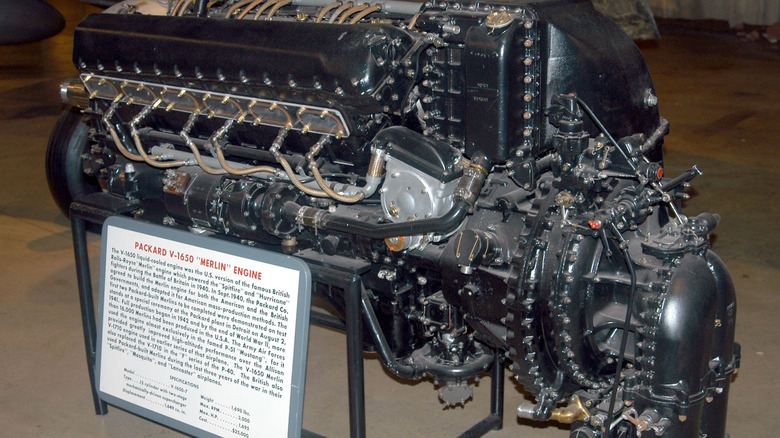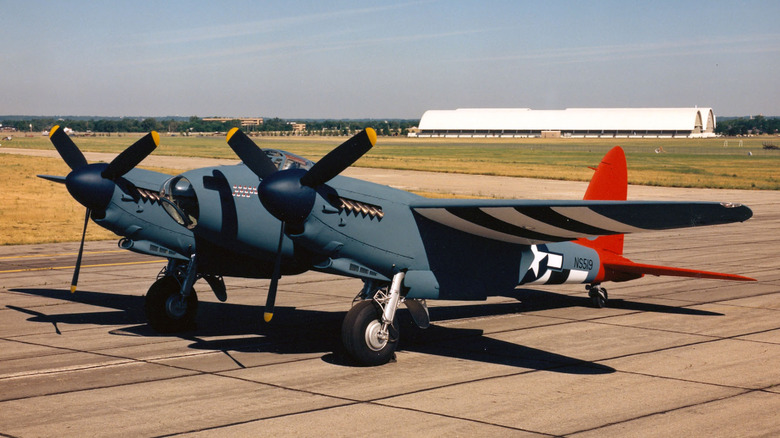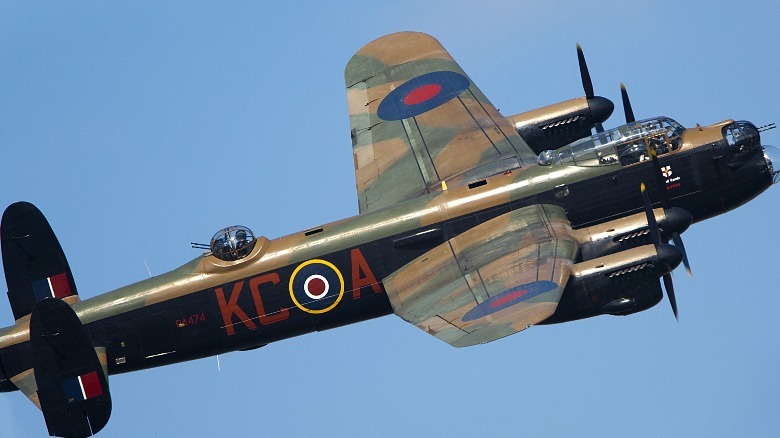Rolls-Royce's Merlin: The Engine That Helped Win WWII
The "D" variant of the North American P-51 Mustang has long been considered one of the greatest aircraft ever to fly. It is considered by many to be one of the leading technological reasons why the United States won the air war over Europe against the forces of the Third Reich. Mustangs have even been credited with defeating the first ever fighter jet, the Nazi-engineered Messerschmitt Me 262, in air-to-air combat. Similarly, the Royal Air Force's iconic Spitfire was instrumental in defending the United Kingdom against the Luftwaffe's onslaught of fighter planes and bombers. A Spitfire defending Britain is also the subject of Iron Maiden's song "Aces High."
Both planes served their respective countries valiantly in battle, and aside from the Mustang and Spitfire both belonging to Allied forces, variants of the Spitfire and the Mustang share an engine, the Rolls-Royce Merlin (the P-51 used a licensed copy of the Merlin built by Packard). The Merlin was produced in several variants in the years leading up to and during World War II and served within the engine bays of numerous aircraft that helped turn the tide of the war.
An engine for all altitudes
The Merlin is a supercharged 12-cylinder engine with a displacement of 1,649 cubic inches (about 27 liters). It first saw production in 1936 and was made until 1956. Initially, it was an English-only powerplant, with planes like the Hawker Hurricane and the aforementioned Spitfire utilizing the Merlin. As the war heated up, American manufacturers like Packard joined in. The American version went by the much less imaginative V-1650 nomenclature.
Getting into an airborne gunfight is not the usual use-case scenario for a car engine. However, fighter plane engines need to operate in the highest stress environments imaginable at many different altitudes, and the Merlin was tweaked and adjusted to dominate wherever it was flying. For example, right from the war's outset, the Merlin performed well in Spitfires at high altitudes. Still, its fuel delivery system and supercharger suffered when engaging in combat aerobatic maneuvers at lower altitudes. Eventually, the wrinkles were ironed out, and the Spitfire was then put on even ground with the Third Reich's Messerschmitt Bf-109.
Initially, the Merlin was not the engine of choice for the P-51; that would be a powerplant made by Allison. The Allison engine had the opposite problem of the Merlin; it conked out at higher altitudes, leading the United States Army Air Forces (the Air Force was not yet a separate branch of the military) to adopt the Merlin for use in the Mustang, earning it the "D" designation.
The heart of the Mustang
Now, with an upgraded power plant, the P-51D Mustang quickly became one of the most dominant American planes in the war, scoring 4,950 air kills just in Europe over the last full year. The Merlin's 1,695 horsepower allowed the Mustang to reach an astonishing top speed of 437 miles per hour and climb to a combat ceiling of 41,900 feet. The Messerschmitt Bf-109 could only top out at 426 miles per hour and a ceiling of 41,400 feet with its 12-cylinder supercharged engine. With help from the Merlin, the P-51D nullified the Bf-109's ill-gotten de-facto lease on European air space.
Before the P-51D arrived in 1944 with its upgraded engine, English engineers were hard at work making the Merlin-powered Spitfire an adaptable fighter in every theater. Much like the United States, the Royal Air Force needed to make a plane that could fight Imperial Japanese Zeros in the Pacific and Nazi aircraft in Europe. As a result, there were numerous variations of the Spitfire. One such variation of Spitfire was the Mark V, essentially a flying gun that could be outfitted to carry as many as eight machine guns or four 20-millimeter cannons and four machine guns. For comparison, an Imperial Japanese Zero had two cannons and two machine guns, and a Bf 109 had one cannon and two machine guns. The Merlin gave the Spitfire the necessary horsepower it needed to carry around all of that firepower.
Bombers and scout planes
The Mustang and Spitfire were by far the most famous recipients of the Merlin, but one can't forget about both the Avro Lancaster and De Haviland Mosquito, two vital planes to the war effort. The Avro Lancaster bomber plane helped the Allies in the early stages of the war make strategic bombing raids on Nazi targets early in the war and helped strengthen the American fleet of B-17 Flying Fortresses and other Allied bombers. Each Lancaster was powered by four Merlins, giving it all the horsepower it needed for bombing and reconnaissance sorties.
The De Haviland Mosquito, a plane made out of wood, served wherever the Royal Air Force needed it. If needed, it could be a night reconnaissance plane, a bomber, or a fighter plane. The Merlin's performance at all altitudes and environments made it the perfect engine for the job and more than 8,000 Mosquitos to leave the factory and help fight the war.
The Merlin's strength was in its flexibility and the fact it was an all-around great engine. It was equally at home within a bomber or a fighter and gave pilots reliable power when it was needed most, regardless of altitude. The Merlin supplied the power and grunt needed to carry heavy bombers and the speed needed to give fighter planes the competitive edge to knock enemy fighter planes out of the sky.
